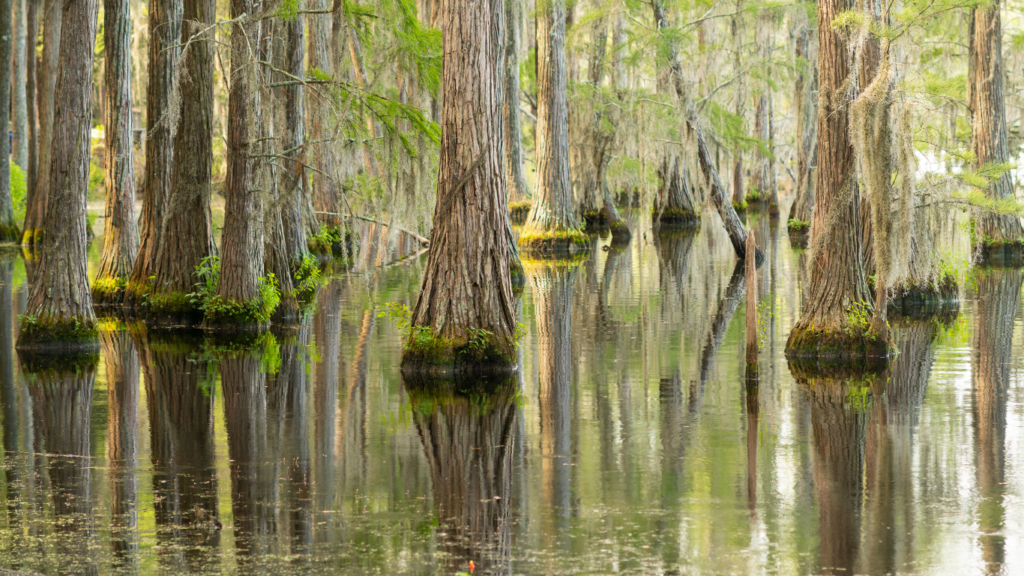By Amy Wold, LWF Policy Director
A master plan development process to focus on the restoration and conservation of the Atchafalaya River basin got its public launch on Oct. 1 with a webinar hosted by the Louisiana Coastal Protection and Restoration Authority (CPRA). It’s been 26 years since the last Atchafalaya Basin Floodway System Louisiana Project State Master Plan was put in place in 1998 and a lot has changed.
The plan, much like the state’s Coastal Master Plan, will provide the vision for the Atchafalaya River basin and guide project prioritization and funding towards larger goals of restoring natural process, ensuring management of habitats for the basin’s health, protecting cultural heritage, and supporting the Atchafalaya River as a working river system. While the plan won’t address flood risk, how water moves through the system is a big concern. Years of canal dredging and other work has led to impounding of water in certain areas, increase in sediment deposits, and lack of water in other areas.
Considerations for the new plan will include how to improve hydrology, address increasing sedimentation, improve water quality, ensure navigation, as well as address stakeholder priorities, interests, and the many public and commercial uses of the river basin.
A diverse group of team members are working on the plan, led by CPRA, including universities, private engineering companies, researchers, and more who are being informed through stakeholder groups representing government, fishermen, recreational users, and more.
The road to this newest master plan process has been a long one.
The Atchafalaya River system is managed by the U.S. Army Corps of Engineers with the Atchafalaya Basin Floodway System Louisiana Feasibility Study in 1982 focused on addressing flood control, the maintenance of the 30-70 water flow split from the Mississippi River, and the development of a plan for protection of the Atchafalaya Basin resources. In 1998, Louisiana, through the then-state Department of Natural Resources (DNR) released the state Atchafalaya Basin Program Master Plan which has been the basis of annual plans ever since produced by DNR 2010-2019. In 2018, the Louisiana Legislature transferred the Atchafalaya Basin Program to CPRA who produced annual plans for the basin starting in 2020.
In 2020, Governor Edwards created the Atchafalaya River Basin Restoration and Enhancement (ARBRE) Task Force. The Task Force released recommendations in 2021 which included the need to update the 1998 master plan.
The Louisiana Wildlife Federation’s (LWF) several affiliates located in and around the Atchafalaya River Basin have been working for years to help improve fish, wildlife, and natural habitats that make up this amazing and diverse basin. The Atchafalaya River Basin has been impacted by a long history of navigation, flood control, oil and gas development, and other projects that have altered the water movement through the basin in various ways including obstruction of flow by canal spoil banks. These changes in hydrology have in turn negatively impacted wildlife, fisheries, and forest health were discussed within the 1998 Master Plan and through the subsequent annual plans that laid out priorities such as the restoration project in East Grand Lake.
LWF and its members have continued to voice support for efforts to implement water management plans within the floodway system (just a few more recent examples here, here, and here). With the launch of a new master plan process, it is a perfect time to step back and take a comprehensive look at the current state of the basin and envision a future with sustainable wildlife, fisheries, forestry, use and appreciation of this 600,000-acre gem in the heart of Louisiana’s coast.
Stay tuned as CPRA and the Atchafalaya Master Plan team will be asking the public soon to submit project ideas to be considered for the new plan. In addition, a presentation on the process is expected to be given at the CPRA board meeting Nov. 20, 2024.

